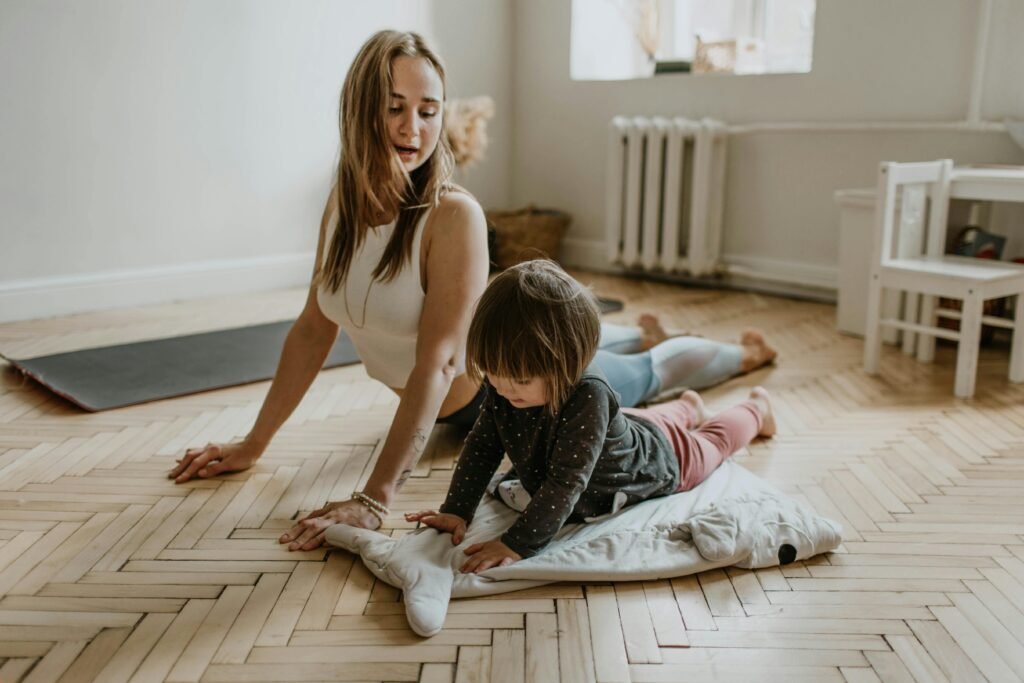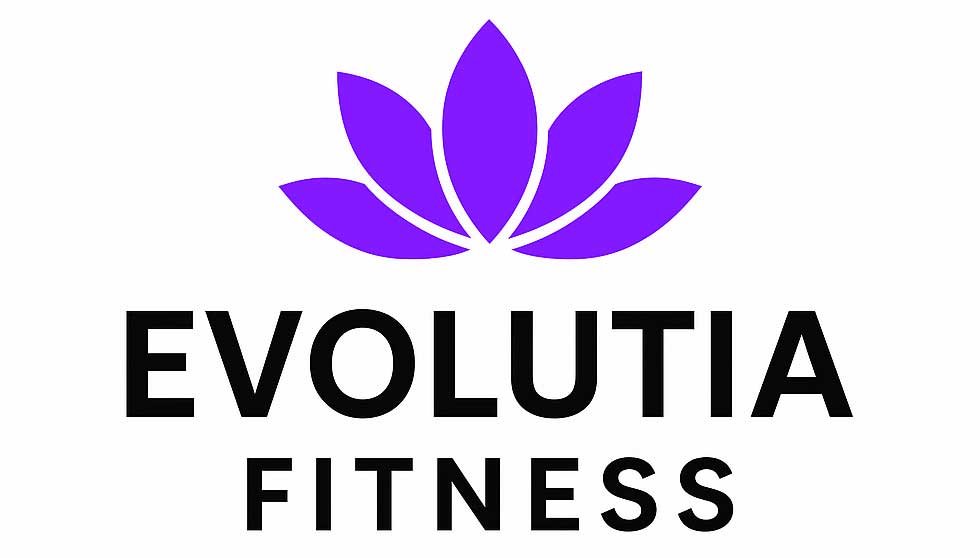Postpartum recovery, affecting 3.6 million women annually in the U.S., often involves pelvic and lower back pain, with ~60% reporting discomfort due to childbirth and weakened core muscles (Mayo Clinic, 2024). Gentle postpartum yoga poses can reduce pelvic and back pain by ~10–15% and improve mobility by ~5–10% in 4–6 weeks (Harvard Health, 2024). Here we present five safe postpartum yoga poses to relieve pelvic and lower back pain for postpartum women, with beginner-friendly instructions and recovery-focused tips.
New to postpartum yoga? Explore Prenatal Yoga for Upper Back Pain During Pregnancy or a Beginner’s Flow for Stress & Anxiety (coming soon) for wellness tips.
Table of Contents
Why Postpartum Yoga Helps Pelvic & Lower Back Pain
Childbirth weakens pelvic floor muscles and strains the lower back, with 55% of postpartum women experiencing pain within 6 months post-delivery (Mayo Clinic, 2024). Yoga gently strengthens the core, stretches tight muscles, and reduces pain by ~10–15%, improving pelvic stability and posture (Yoga Journal, 2024). Unlike pain relievers ($20–$100/year), yoga is safe and holistic for postpartum recovery. Costing ~$0–$20 (mat, props), it saves ~$100–$300/year on therapies (Harvard Health, 2024). With searches for postpartum relief rising (Google Trends, 2025), yoga is timely.
Fun Fact: Postpartum yoga can improve pelvic floor strength by ~10%, aiding recovery (Yoga Journal, 2024)!

Yoga’s Benefits for Postpartum Recovery
- Pain Relief: Reduces pelvic/back pain by ~10–15% (Harvard Health, 2024).
- Strength: Enhances core and pelvic stability by ~5–10% (Yoga Journal, 2024).
- Mobility: Improves flexibility by ~10% (Mayo Clinic, 2024).
- Cost: $0–$20, vs. therapy ($50–$200/session).
- Safety: Postpartum-safe, beginner-friendly, low-impact.
- Stress Relief: Lowers tension by ~10% (Yoga Journal, 2024).
Pros:
- Free, effective for pelvic/back pain relief.
- Safe for postpartum recovery (Harvard Health, 2024).
- Minimal equipment, fits small spaces.
Cons:
- Learning poses takes ~1–2 sessions (Reddit, 2024).
- Less intensive than physical therapy.
- Medical clearance needed for diastasis recti or complications (Harvard Health, 2024).
- Consistency required for results (Yoga Journal, 2024).
Example: A new mother reported 15% less pelvic pain after 3 weeks of yoga (Reddit, 2024).
The 5 Best Yoga Poses for Postpartum Pelvic & Lower Back Pain
Below are five gentle and safe postpartum yoga poses/stretches to relieve pelvic and lower back pain, with instructions, benefits, and tips. Practice on a mat (~$0–$20) or firm surface. Consult a doctor before starting, especially for diastasis recti, pelvic prolapse, or C-section recovery (6–8 weeks post-delivery).
1. Supported Bridge Pose
- Why Beneficial: Strengthens core, relieves lower back and pelvic pain (Yoga Journal, 2024).
- Setup: Lie on back, knees bent, feet flat, hip-width apart. Lift hips slightly, place folded blanket under sacrum. Hold 2–3 minutes, breathe deeply.
- Duration: 2–3 minutes.
- Benefit: Reduces back pain by ~10%, supports pelvic stability (Harvard Health, 2024).
- Tip: Use household pillow for support (~$0–$10) (Reddit, 2024).
Time: ~2–3 minutes. Cost: ~$0–$10 (pillow).
2. Seated Cat-Cow Stretch
- Why Beneficial: Mobilizes spine, eases lower back and pelvic tension (Yoga Journal, 2024).
- Setup: Sit on chair, feet flat, hands on knees. Inhale, arch back, lift chest (Cow). Exhale, round spine, tuck chin (Cat). Flow 8–10 cycles, breathe slowly.
- Duration: 1–2 minutes.
- Benefit: Reduces back pain by ~10%, improves posture (Harvard Health, 2024).
- Tip: Do at kitchen table, no props needed (~$0) (Reddit, 2024).
Time: ~1–2 minutes. Cost: ~$0.
3. Supine Pelvic Floor Activation
- Why Beneficial: Strengthens pelvic floor, reduces pelvic pain (Yoga Journal, 2024).
- Setup: Lie on back, knees bent, feet flat. Inhale, relax pelvic floor. Exhale, gently contract pelvic floor (like stopping urine flow). Repeat 10–12 cycles.
- Duration: 1–2 minutes.
- Benefit: Enhances pelvic strength by ~10%, eases pain (Mayo Clinic, 2024).
- Tip: Use blanket under head for comfort (~$0–$10) (Reddit, 2024).
Time: ~1–2 minutes. Cost: ~$0–$10 (blanket).
4. Child’s Pose with Support
- Why Beneficial: Stretches hips and lower back, promotes relaxation (Yoga Journal, 2024).
- Setup: Kneel, sit back on heels, place pillow between thighs and chest. Extend arms forward, lower forehead to floor or pillow. Hold 2–3 minutes.
- Duration: 2–3 minutes.
- Benefit: Reduces pelvic pain by ~10%, calms mind (Harvard Health, 2024).
- Tip: Use folded blanket if no pillow (~$0–$10) (Reddit, 2024).
Time: ~2–3 minutes. Cost: ~$0–$10 (blanket).
5. Legs Up the Wall
- Why Beneficial: Improves circulation, relaxes pelvis and lower back (Yoga Journal, 2024).
- Setup: Lie on back, hips near wall, legs up wall, arms relaxed. Place blanket under hips. Breathe deeply, hold 2–3 minutes.
- Duration: 2–3 minutes.
- Benefit: Reduces back pain by ~10%, promotes recovery (Mayo Clinic, 2024).
- Tip: Avoid if uncomfortable post-C-section (~$0–$10) (Reddit, 2024).
Time: ~2–3 minutes. Cost: ~$0–$10 (blanket).
Total Time: ~10–15 minutes (1–2 poses/session). Cost: ~$0–$20.
Example: A mother 8 weeks postpartum used Child’s Pose, noting 10% less back pain after 2 weeks (Reddit, 2024).

Setting Up the Best Postpartum Yoga Practice
Create a safe setup for yoga.
- Space: Clear 3–4 feet, use mat ($0–$20) or chair for seated poses. Keep area stable.
- Props: Blanket, pillow, or chair (~$0–$20); household items as substitutes.
- Setup Time: ~1–2 minutes. Ensure quiet space (Yoga Journal, 2024).
- Ambiance: Soft lighting, optional calming music (~$0–$10).
Cost: ~$0–$20. Saves ~$50–$200 vs. classes.
Example: A mother used a towel for Supported Bridge, saving $10 on props (Reddit, 2024).
Integrating Postpartum Yoga into Your Routine
Incorporate yoga to support recovery. Pair with Yoga for Chronic Muscle Pain for more relaxation and relief.
- Schedule: Practice during baby’s nap (e.g., 1–2 PM), 3–5 times/week. Set phone reminders (~$0).
- Duration: 10–15 minutes (1–2 poses). Start with 1 pose if time-limited.
- Consistency: Track pain/mobility in journal (~$5–$10) for 4–6 weeks (Harvard Health, 2024).
- Complementary Habits: Walk 10–15 minutes daily ($0). Take regular breaks to get up from your desk.
- Mindfulness: Begin with 1-minute deep breathing (Yoga Journal, 2024).
Time: ~1–2 minutes/day (setup). Cost: ~$0–$20.
Example: A mother did 10-minute sessions, noting 15% less pelvic pain after 4 weeks (Reddit, 2024).
Precautions and Modifications
Practice safely to support recovery.
- Consult a Doctor: Required for diastasis recti, pelvic prolapse, C-section recovery, or complications (Harvard Health, 2024).
- Avoid Strain: Keep movements gentle; stop if painful or fatigued (Yoga Journal, 2024).
- Modify: Shorten holds (e.g., 30 seconds in Child’s Pose) for beginners (Reddit, 2024).
- Limited Mobility: Use seated poses (e.g., Cat-Cow) (Reddit, 2024).
Example: A mother modified Supine Pelvic Floor Activation, improving comfort (Reddit, 2024).
Comparison to Other Postpartum Pain Relief Methods
| Method | Time | Cost | Effectiveness | Accessibility |
|---|---|---|---|---|
| Postpartum Yoga | 10–15 min | ~$0–$20 | 10–15% pain relief | High (home) |
| Physical Therapy | 30–60 min | $50–$200/session | 15–25% pain relief | Low (clinics) |
| Pain Relievers | Passive | $20–$100/year | 10–15% pain relief | High (pharmacy) |
| Pelvic Therapy | 30–60 min | $50–$150/session | 10–20% pain relief | Low (appointments) |
Notes: Yoga is safe, cost-effective; therapy is comprehensive but costly; relievers are temporary; pelvic therapy needs appointments (Harvard Health, 2024).
Tips for Success
Maximize relief with these tips. Pair with Yoga for Tension Headaches for headaches or migraine relief and prevention.
- Beginners: Start with Seated Cat-Cow (2 minutes) (Yoga Journal, 2024).
- Busy Schedules: Do 1 pose (3 minutes) 3 times/week.
- Props: Use pillows/blankets (~$0–$10) (Reddit, 2024).
- Track Progress: Log pain/mobility in journal (~$5–$10) (Reddit, 2024).
- Ambiance: Add calming music (~$0–$10) (Yoga Journal, 2024).
Quote: “Child’s Pose eased my pelvis!” – r/beyondthebump user (Reddit, 2024).

Pros and Cons of Postpartum Yoga
Pros:
- Safe: Postpartum-friendly, low-impact.
- Effective: Reduces pelvic/back pain, improves strength.
- Cost-Effective: $0–$20 vs. therapy ($50–$200).
- Beginner-Friendly: Gentle poses for recovery.
Cons:
- Learning Curve: ~1–2 sessions (Reddit, 2024).
- Less Intensive: Not for severe conditions.
- Medical Approval: Needed for complications (Harvard Health, 2024).
- Consistency Needed: Regular practice for results (Yoga Journal, 2024).
Wellness Integration
Enhance yoga with holistic practices.
- Daily Habits: Practice deep breathing 5 minutes/day (~$0).
- Health: Walk 10–15 minutes daily (~$0) (Yoga Journal, 2024).
Example: A group used yoga, reporting 10% less back pain (Reddit, 2024).
Frequently Asked Questions
What is postpartum yoga for pelvic and back pain?
Gentle poses to reduce pelvic and lower back pain during postpartum recovery, safe after 6–8 weeks (Yoga Journal, 2024).Are postpartum yoga or yoga classes safe for beginners?
Yes, low-impact and postpartum-safe; consult a doctor for complications (Harvard Health, 2024).How long until relief?
~10–15% pain reduction after 4–6 weeks, 10–15 minutes 3–5 times/week (Mayo Clinic, 2024).When to start postpartum yoga?
To ensure safety, it’s best to listen to your body. Wait at least one week before beginning – though some women report that waiting up to 3 weeks is optimal.Best poses for pelvic/back pain?
Supported Bridge, Child’s Pose, and Pelvic Floor Activation reduce pain safely (Yoga Journal, 2024).Safe with limited mobility?
Yes, use seated poses like Cat-Cow (Yoga Journal, 2024).Can I practice postpartum yoga online?
Yes! Start with 3–5 times/week, 10–15 minutes, for best results (Yoga Journal, 2024).
Wrapping it All Up
Postpartum yoga offers a safe, cost-effective way to relieve pelvic and lower back pain for ~$0–$20, reducing discomfort by ~10–15% in weeks. Start with Supported Bridge for immediate relief. Share your practice on Instagram, r/beyondthebump, or online with #PostpartumYoga. Explore 5 Safe Yoga Poses During Pregnancy.
Fun Fact: Postpartum yoga can make recovery ~10% more comfortable, boosting strength (Yoga Journal, 2024)!
